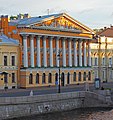Pyotr Rumyantsev
Count Pyotr Rumyantsev Zadunaisky | |
|---|---|
Пётр Румянцев | |
Namestnichestvos | |
| In office 1782–1796 | |
| Monarchs | Catherine the Great (1782–1796), Paul I (1796) |
| Deputy | Mikhail Krechetnikov (1791–1793), Iosif Igelström (1793–1794) |
| Preceded by | office created |
| Succeeded by | office liquidated |
| Personal details | |
| Born | Pyotr Aleksandrovich Rumyantsev 15 January 1725 Field Marshal |
| Battles/wars | Tree List:
|
Count Pyotr Alexandrovich Rumyantsev-Zadunaisky
He governed
Early life
Pyotr came from the
Pyotr Alexandrovich first saw military service under his nominal father in the
His first military glory dates from the great battles of the Seven Years' War (1756–1763), those of Gross-Jägersdorf (1757) and Kunersdorf (1759). In 1761 he besieged and took the Pomeranian fortress of Kolberg,[9][10] which had twice been unsuccessfully beleaguered by other Russia's commanders; thus clearing for Russian armies the path to Berlin. The siege of Kolberg of 1761 was an important milestone in the development of Russian military art. Here Rumyantsev pioneered a new tactic — the action of troops in battalion (regimental) columns, combined with a scattered formation of jaegers.[11]
First Russo-Turkish War
Throughout the reign of
With the outbreak of the
Second Russo-Turkish War
By that point, Rumyantsev had undoubtedly become the most famous Russian commander. Other Catharinian generals, notably
During the
As the story goes, old Rumyantsev-Zadunaisky grew enormously fat and avaricious, so that he pretended not to recognize his own sons when they came from the capital to ask for money. Under his son Sergey's administration, Tashan fell into ruins, although he erected a
Awards
Rumyantsev was awarded the following honors:[6]
- Order of St. Alexander Nevsky(1759);
- Order of St. Andrew (1762);
- Order of St. George 1st Class (1770);
- Order of St. Vladimir1st Class (1782);
- Golden Weapon for Bravery (1775, 1791/92).
Gallery
-
Portrait of Field Marshal Pyotr Rumyantsev-Zadunaisky.[c] Unknown artist of the late 18th century.
-
Portrait of Count Pyotr Alexandrovich Rumyantsev-Zadunaisky. Painting of the 1790s by Salvatore Tonci.
-
Pyotr Alexandrovich Rumyantsev, 18th century, unknown author
-
Rumyantsev Zadunaysky Mansion, built in 1782.[d]
-
Nikolai Rumyantsev's mansion onEnglish Quay, St. Petersburg
-
Kachanivka Palace, Ukraine
See also
- Operation Polkovodets Rumyantsev
Notes
- ^ His name Pyotr is also anglicized as Peter.
The full name is also transliterated as Pyotr Aleksandrovich Rumyantsev-Zadunaysky. - ^ Pre-1918 orthography: Петръ Александровичъ Румянцевъ-Задунайскій
- ^ The portrait shows Rumyantsev in a fieldmarshal's uniform with gold embroidery on the collar, sides, and sleeves. Ribbons of the Orders of St. Andrew and St. George 1st Class are worn over the caftan. On the chest of the Field Marshal are embroidered stars of these awards.
- ^ A number of researchers called the famous architect of the project Vasily Bazhenov, others attribute the construction to M. F. Kazakov. There is no consensus on the issue; it is possible that both the architects were involved in the project.
References
- ^ a b Vartichan & Andrunakievich (1982), p. 535
- ^ a b Korobkov 1947, p. 5.
- ^ a b Meerovich 1987, p. 8.
- ^ Bodart 1908, p. 789.
- ^ Longworth, Philip (1966). The Art of Victory: The Life and Achievements of Field-Marshal Suvorov, 1729-1800 (1st ed.). Holt, Rinehart & Winston. p. 28.
- ^ a b "РУМЯНЦЕВ-ЗАДУНАЙСКИЙ ПЁТР АЛЕКСАНДРОВИЧ • Great Russian Encyclopedia – Electronic version". old.bigenc.ru. 2023. Retrieved 11 August 2023.
- ^ Bain, Robert Nisbet (1911). . In Chisholm, Hugh (ed.). Encyclopædia Britannica. Vol. 3 (11th ed.). Cambridge University Press. p. 840.
- ^ Kuzmin 2017.
- ^ Bain, Robert Nisbet (1911). . In Chisholm, Hugh (ed.). Encyclopædia Britannica. Vol. 9 (11th ed.). Cambridge University Press. p. 285.
- ^ "Pyotr Aleksandrovich Rumyantsev, Count Zadunaysky | Russian military officer". Encyclopedia Britannica. Retrieved 30 August 2019.
- ^ Tashlykov 2016.
Sources
- Bodart, Gaston (1908). Militär-historisches Kriegs-Lexikon (1618-1905) (in German). Vienna and Leipzig: C. W. Stern. Retrieved 7 July 2022.
{{cite book}}: CS1 maint: date and year (link) - Korobkov, Nikolay Mikhailovich (1947). Фельдмаршал Румянцев [Field Marshal Rumyantsev] (in Russian). Moscow: Политгиз.
- Meerovich, Grigory Ilyich (1987). Румянцев в Петербурге [Rumyantsev in Petersburg] (in Russian). Leningrad: Лениздат.
- Andrunakievich, Vladimir Aleksandrovich; Vartichan, Iosif Konstantinovich (1982). Советская Молдавия: краткая энциклопедия [Soviet Moldavia: short encyclopedia] (in Russian). Kishinev: Глав. ред. Молдавской Сов. энциклопедии.
- Tashlykov, S. L. (2016). "КОЛЬБЕРГА ОСАДЫ". Great Russian Encyclopedia. Electronic version. Retrieved 9 May 2023.
- Kuzmin, A. V. (2017). "РУМЯНЦЕВЫ". Great Russian Encyclopedia. Electronic version. Retrieved 2 October 2023.

![Portrait of Field Marshal Pyotr Rumyantsev-Zadunaisky.[c] Unknown artist of the late 18th century.](http://upload.wikimedia.org/wikipedia/commons/thumb/9/92/Rumjanzew-sadunaiski.jpg/88px-Rumjanzew-sadunaiski.jpg)


![Rumyantsev Zadunaysky Mansion, built in 1782.[d]](http://upload.wikimedia.org/wikipedia/commons/thumb/4/4d/Rumyantsev_Zadunaysky_Mansion.jpg/120px-Rumyantsev_Zadunaysky_Mansion.jpg)



